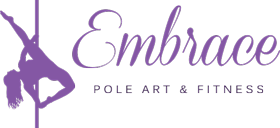By Jenna Dahl
I recently had a conversation with a student who felt like their progression had stalled. Every pole dancer—whether beginner or seasoned—eventually hits a plateau. You might be showing up consistently, pushing yourself in classes, and still feel like you’re not getting any stronger, more flexible, or more advanced. It’s frustrating, disheartening, and honestly I am here to say that is all okay! But hitting a wall doesn’t mean you’ve stopped progressing—it just means it’s time to adjust your approach. What used to work in the past might not be the right fit for the level you are at anymore.
It is also okay to hit a plateau and be fine with that! As most of my students hear me say, comparison is the thief of joy. You do not need to be progressing at the rate you feel others are. Other students may also feel like they are plateauing and you feel like they aren’t. (We will write about how to be an encouraging training partner later).
If you want to focus on shifting your progression, here are some practical steps and considerations to help you move through the stall and rediscover momentum in your pole journey.
1. Assess Your Training Routine
When progress slows, the first place to look is your current training habits. Ask yourself:
- Are you training too much or too little?
- Are you doing a variety of styles (spin/static, strength, dynamic, flexibility)?
- Are you giving yourself enough rest and recovery?
Sometimes, stalling happens because your body is overworked and under-recovered. Other times, it’s the opposite—you’re not challenging your body in new ways. Keeping a training log for a couple of weeks can help highlight patterns and gaps.
Need a training log template? Check ours out here.
2. Get Specific About Your Goals
What does progress really mean to you? Why do you feel like you’re plateauing? Make sure you take time to define what progress feels like for you specifically. Do you want to:
- Nail a particular trick?
- Increase your strength or flexibility?
- Feel more confident in choreography?
Once you’re clear about your goal, you can reverse-engineer your training to support it. For example, if you want to finally get your aerial invert, you may need to focus on targeted strength-building drills instead of just repeating the invert attempt over and over.
3. Incorporate Cross-Training
Pole is a demanding, full-body discipline, but sometimes it can’t meet all your physical development needs on its own. That is why we provide a variety of classes to help keep your training well rounded. Strength training, mobility work, and cardio can all complement your pole practice and help break through plateaus.
Consider adding:
- Pole conditioning classes
- Yoga or mobility classes for active flexibility.
- Dance or flow-based movement to improve transitions and musicality.
4. Ask for Instructor Feedback
When you’re in your own body, it can be hard to identify what’s holding you back. A trained instructor might spot something you can’t see—like hand placement, core engagement, or fear-based hesitations.
You can:
- Ask for a one-on-one or a private lesson focused on your challenge.
- Record your training and ask an instructor to review it.
- Come to our Tricks and Troubleshooting classes to focus on specific tricks that are stumping you
5. Change Up Your Routine
If your body and brain are bored, you might not be pushing yourself in ways that spark growth. Consider:
- Trying a different pole style (e.g., heels if you usually train barefoot).
- Signing up for a choreography class instead of tricks.
- Relearning beginner tricks with better form or a different style (check out our article on the benefits of going to lower level classes)
Sometimes, growth comes from sideways exploration, not just climbing upward.
6. Rest Without Guilt
Rest is progress. This is one of the lessons that took me the longest to learn, please learn from my mistakes! Overtraining can lead to fatigue, irritability, injuries, and stalled performance. Take a week off, do only restorative movement, or focus on non-physical aspects of pole like watching routines, journaling goals, or curating playlists. Many pole dancers return from rest periods with renewed motivation and unexpected breakthroughs.
7. Check Your Mindset
Progress is not always linear or visible. Consider:
- Are you being too hard on yourself?
- Are you comparing your journey to others’?
- Are you celebrating the small wins?
Mindset can be the hidden cause behind a plateau. A growth mindset reminds us that stalling is just part of the learning curve, not a sign of failure.
8. Reconnect With Your “Why”
Pole is about more than just nailing moves—it’s about empowerment, expression, strength, and joy. Reconnecting with what brought you to pole in the first place can reignite your motivation. Journal about your journey. Watch your early videos to see how far you’ve come. Dance just for you, not for progress or praise.
Final Thoughts
A stall in your progression doesn’t mean the journey is over. Often, it means you’re on the cusp of a breakthrough. Progress might not look like a new trick—it might look like cleaner lines, more body awareness, or deeper confidence. By stepping back, reassessing, and being kind to yourself, you’ll not only move through the plateau—you’ll come out of it a stronger, more well-rounded pole dancer.

